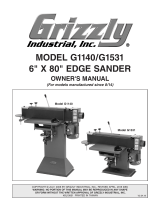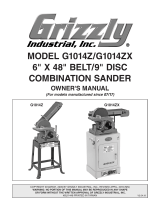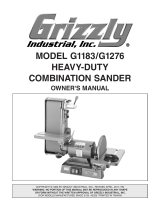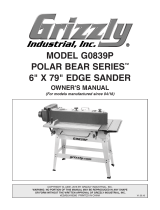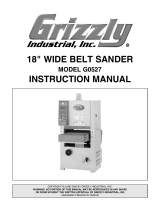Page is loading ...

COPYRIGHT © MAY, 2003 BY GRIZZLY INDUSTRIAL, INC.
WARNING: NO PORTION OF THIS MANUAL MAY BE REPRODUCED IN ANY SHAPE
OR FORM WITHOUT THE WRITTEN APPROVAL OF GRIZZLY INDUSTRIAL, INC.
#528603624 PRINTED IN TAIWAN
ONLINE MANUAL DISCLAIMER
THE INFORMATION IN THIS MANUAL REPRESENTS THE CONFIGURATION OF THE MACHINE AS IT IS CURRENTLY BEING SHIPPED. THE MACHINE
CONFIGURATION CAN CHANGE AS PRODUCT IMPROVEMENTS ARE INCORPORATED. IF YOU OWN AN EARLIER VERSION OF THE MACHINE, THIS
MANUAL MAY NOT EXACTLY DEPICT YOUR MACHINE . CONTACT CUSTOMER SERVICE IF YOU HAVE ANY QUESTIONS ABOUT DIFFERENCES. PRE-
VIOUS VERSIONS ARE NOT AVAILABLE ONLINE.
EDGE SANDER
MODEL G0512
INSTRUCTION MANUAL

WARNING
Some dust created by power sanding, sawing, grind-
ing, drilling, and other construction activities contains
chemicals known to the State of California to cause
cancer, birth defects or other reproductive harm.
Some examples of these chemicals are:
• Lead from lead-based paints.
• Crystalline silica from bricks, cement, and
other masonry products.
• Arsenic and chromium from chemically treated
lumber.
Your risk from these exposures varies, depending on
how often you do this type of work. To reduce your
exposure to these chemicals: work in a well ventilated
area, and work with approved safety equipment, such
as those dust masks that are specially designed to fil-
ter out microscopic particles.

SECTION 1: SAFETY........................................................................................................................2
Safety Instructions For Power Tools ..........................................................................................2
Additional Safety Instructions For Sanders ................................................................................4
SECTION 2: INTRODUCTION ..........................................................................................................5
SECTION 3: CIRCUIT REQUIREMENTS ........................................................................................6
Grounding....................................................................................................................................7
Extension Cords..........................................................................................................................7
SECTION 4: IDENTIFICATION ........................................................................................................8
SECTION 5: SET UP ........................................................................................................................9
Unpacking ..................................................................................................................................9
G0512 Inventory..........................................................................................................................9
Hardware Recognition Chart ....................................................................................................10
Clean Up ..................................................................................................................................11
Site Considerations ..................................................................................................................11
Beginning Assembly..................................................................................................................12
Installing Feet............................................................................................................................12
Installing Tension Lever ............................................................................................................13
Installing Sanding Belt ..............................................................................................................13
Attaching Dust Port ..................................................................................................................14
Installing Roller Guard ..............................................................................................................15
Test Run & Tracking ................................................................................................................15
Installing Table ..........................................................................................................................16
Installing Back Stop ..................................................................................................................18
Connecting to Dust Collection System......................................................................................18
SECTION 6: OPERATIONS ............................................................................................................19
Power Switch ............................................................................................................................19
Adjusting Table Height..............................................................................................................20
Sanding Belt Selection..............................................................................................................20
Edge & End Sanding ................................................................................................................21
Contour Sanding ......................................................................................................................22
SECTION 7: MAINTENANCE ........................................................................................................23
General......................................................................................................................................23
Table ........................................................................................................................................23
Lubrication ................................................................................................................................23
Sanding Belt..............................................................................................................................23
SECTION 8: SERVICE ADJUSTMENTS ........................................................................................24
About Service............................................................................................................................24
Adjusting Tensioner ..................................................................................................................24
Resetting Tensioner Spring Tension ........................................................................................25
Parallel Belt Tracking ................................................................................................................26
Platen-to-Rollers Adjustments ..................................................................................................28
SECTION 9: REFERENCE INFO ....................................................................................................31
Aftermarket Accessories ..........................................................................................................31
Machine Data Sheet..................................................................................................................32
Parts Breakdown and List ........................................................................................................33
Troubleshooting Machine..........................................................................................................35
Troubleshooting Sanding ..........................................................................................................36
G0512 Wiring Diagram..............................................................................................................37
Warranty and Returns ..............................................................................................................38
TABLE OF CONTENTS

-2-
G0512 Edge Sander
5. KEEP CHILDREN AND VISITORS
AWAY. All children and visitors should be
kept at a safe distance from work area.
6. MAKE WORKSHOP CHILD PROOF with
padlocks, master switches, or by removing
starter keys.
7. NEVER FORCE TOOL. It will do the job
better and safer at the rate for which it was
designed.
8. USE RIGHT TOOL. DO NOT force tool or
attachment to do a job for which it was not
designed.
1. KEEP GUARDS IN PLACE and in working
order.
2. REMOVE ADJUSTING KEYS AND
WRENCHES. Form habit of checking to
see that keys and adjusting wrenches are
removed from tool before turning on.
3. KEEP WORK AREA CLEAN. Cluttered
areas and benches invite accidents.
4. NEVER USE IN DANGEROUS ENVI-
RONMENT. DO NOT use power tools in
damp or wet locations, or where any flam-
mable or noxious fumes may exist. Keep
work area well lighted.
For Your Own Safety Read Instruction
Manual Before Operating This Equipment
Indicates an imminently hazardous situation which, if not avoided,
WILL result in death or serious injury.
Indicates a potentially hazardous situation which, if not avoided,
COULD result in death or serious injury.
Indicates a potentially hazardous situation which, if not avoided,
MAY
result in minor or moderate injury. It may also be used to alert
against unsafe practices.
This symbol is used to alert the user to useful information about
proper operation of the equipment.
The purpose of safety symbols is to attract your attention to possible hazardous conditions.
This manual uses a series of symbols and signal words which are intended to convey the level
of importance of the safety messages. The progression of symbols is described below.
Remember that safety messages by themselves do not eliminate danger and are not a substi-
tute for proper accident prevention measures.
NOTICE
Safety Instructions For Power Tools
SECTION 1: SAFETY

G0512 Edge Sander -3-
9. USE PROPER EXTENSION CORD. Make
sure your extension cord is in good condi-
tion. Conductor size should be in accor-
dance with the chart below. The amperage
rating should be listed on the motor or tool
nameplate. An undersized cord will cause
a drop in line voltage resulting in loss of
power and overheating. Your extension
cord must also contain a ground wire and
plug pin. Always repair or replace exten-
sion cords if they become damaged.
Minimum Gauge for Extension Cords
10. WEAR PROPER APPAREL. DO NOT
wear loose clothing, gloves, neckties,
rings, bracelets, or other jewelry which may
get caught in moving parts. Non-slip
footwear is recommended. Wear protective
hair covering to contain long hair.
11. ALWAYS USE SAFETY GLASSES. Also
use face or dust mask if cutting operation is
dusty. Everyday eyeglasses only have impact
resistant lenses, they are NOT safety glasses.
12. SECURE WORK. Use clamps or a vise to hold
work when practical. It is safer than using your
hand and frees both hands to operate tool.
13. DO NOT OVER-REACH. Keep proper
footing and balance at all times.
14. MAINTAIN TOOLS WITH CARE. Keep
tools sharp and clean for best and safest
performance. Follow instructions for lubri-
cating and changing accessories.
LENGTH
AMP RATING 25ft 50ft 100ft
0-6 16 16 16
7-10 16 16 14
11-12 16 16 14
13-16 14 12 12
17-20 12 12 10
21-30 10 10 No
Safety Instructions For Power Tools
15. USE RECOMMENDED ACCESSORIES.
Consult the owner’s manual for recom-
mended accessories. The use of improper
accessories may cause risk of injury.
16. REDUCE THE RISK OF UNINTENTION-
AL STARTING. On machines with magnet-
ic contact starting switches there is a risk of
starting if the machine is bumped or jarred.
Always disconnect from power source
before adjusting or servicing. Make sure
switch is in OFF position before reconnecting.
17. CHECK DAMAGED PARTS. Before fur-
ther use of the tool, a guard or other part
that is damaged should be carefully
checked to determine that it will operate
properly and perform its intended function.
Check for alignment of moving parts, bind-
ing of moving parts, breakage of parts,
mounting, and any other conditions that
may affect its operation. A guard or other
part that is damaged should be properly
repaired or replaced.
18. NEVER LEAVE TOOL RUNNING UNAT-
TENDED. TURN POWER OFF. DO NOT
leave tool until it comes to a complete stop.
19. NEVER OPERATE A MACHINE WHEN
TIRED, OR UNDER THE INFLUENCE OF
DRUGS OR ALCOHOL. Full mental alert-
ness is required at all times when running a
machine.
20. NEVER ALLOW UNSUPERVISED OR
UNTRAINED PERSONNEL TO OPER-
ATE THE MACHINE. Make sure any
instructions you give in regards to machine
operation are approved, correct, safe, and
clearly understood.
21. IF AT ANY TIME YOU ARE EXPERIENC-
ING DIFFICULTIES performing the intend-
ed operation, stop using the machine! Then
contact our service department or ask a
qualified expert how the operation should
be performed.

-4-
G0512 Edge Sander
Like all power tools, there is danger asso-
ciated with the Edge Sander. Accidents are
frequently caused by lack of familiarity or
failure to pay attention. Use this tool with
respect and caution to lessen the possibil-
ity of operator injury. If normal safety pre-
cautions are overlooked or ignored, seri-
ous personal injury may occur.
No list of safety guidelines can be complete.
Every shop environment is different. Always
consider safety first, as it applies to your
individual working conditions. Use this and
other machinery with caution and respect.
Failure to do so could result in serious per-
sonal injury, damage to equipment or poor
work results.
Additional Safety Instructions For Sanders
• DO NOT allow anyone to stand near the
sander while sanding wood stock.
• DO NOT jam the workpiece against the
sanding belt. Firmly grasp the workpiece in
both hands and ease it against the sanding
belt, using light pressure.
• DO NOT wear loose clothing while operat-
ing this machine. Roll up or button sleeves
at the cuff.
• DO NOT place hands near, or in contact
with, sanding belt during operation.
• ANY PROBLEM, with the exception of belt
tracking, that is concerned at all with any
moving parts or accessories must be
investigated and corrected with the power
disconnected, and after everything has
come to a complete stop.
•
PERFORM machine inspections and main-
tenance service promptly when called for.
• NEVER leave the machine running unat-
tended.
• REPLACE sanding belt when it becomes
worn.
• NEVER sand more than one piece of stock
at a time.
• ALWAYS inspect board stock for nails,
staples, knots, and other imperfections that
could be dislodged and thrown from the
machine during sanding operations.
• NEVER operate the sander without an
adequate dust collection system in place
and running.
• NEVER sand tapered or pointed stock with
the point facing the feed direction.
•ALWAYSwear a dust mask when sand-
ing. Using this machine produces sawdust
which may cause allergic reactions or res-
piratory problems.

G0512 Edge Sander -5-
We are proud to offer the Model G0512 Edge
Sander. This Edge Sander is part of a growing
Grizzly family of fine woodworking machinery.
When used according to the guidelines set forth
in this manual, you can expect years of trouble-
free, enjoyable operation and proof of Grizzly’s
commitment to customer satisfaction.
This sander was developed for those projects
that require a large support area and need the
workpiece to be moved around the roller. The
specially designed small 2
1
⁄2" edge diameter
roller allows you to get into tighter radius projects
like guitar bodies, curved chair legs etc.... The
table is supported in four positions to eliminate
sagging and to provide a stable base while
working, and the quick belt release mechanism
makes it easy to change belts fast.
We are pleased to provide this manual with the
Model G0512. It was written to guide you through
assembly, to review safety considerations, and to
cover general operating procedures. It repre-
sents our effort to produce the best documenta-
tion possible.
If you have any comments regarding this manual,
please write to us at the address below:
Grizzly Industrial, Inc.
C
/O Technical Documentation
P.O. Box 2069
Bellingham, WA 98227-2069
Most importantly, we stand behind our machines.
If you have any service questions or parts
requests, please call or write us at the location
listed below.
Grizzly Industrial, Inc.
1203 Lycoming Mall Circle
Muncy, PA 17756
Phone: (570) 546-9663
Fax: (800) 438-5901
E-Mail: [email protected]
Web Site: http://www.grizzly.com
The specifications, drawings, and photographs
illustrated in this manual represent the Model
G0512 as supplied when the manual was pre-
pared. However, owing to Grizzly’s policy of con-
tinuous improvement, changes may be made at
any time with no obligation on the part of Grizzly.
For your convenience, we always keep current
Grizzly manuals available on our website at
www.grizzly.com
. Any updates to your machine
will be reflected in these manuals as soon as they
are complete. Visit our site often to check for the
latest updates to this manual!
SECTION 2: INTRODUCTION
Read the manual before
assembly and operation.
Serious personal injury
may result if safety or
operational information
is not understood or fol-
lowed.

-6-
G0512 Edge Sander
SECTION 3: CIRCUIT REQUIREMENTS
Amperage Draw
The Model G0512 features a 110V/220V motor
that is prewired at 220V.
Motor Load at 220V ..............................10 amps
Motor Load at 110V ..............................20 amps
Plug Type
The cord set enclosed does not have a plug as
the style of plug you require will depend upon the
type of service you currently have or plan to
install. We recommend using the following plugs
for your machine on a dedicated circuit only (see
Figures 1 & 2 for an example):
220V Plug & Receptacle..............................6-15
110V Plug & Receptacle..............................5-20
Circuit Breaker Requirements
Please use the following guidelines when choos-
ing a circuit breaker for your machine (circuit
breakers rated any higher are not adequate to
protect the circuit):
220V Circuit Breaker ..............................10 amp
110V Circuit Breaker ..............................20 amp
Your Circuit Capacity
Always check to see if the wires in your circuit are
capable of handling the amperage load from your
machine. If you are unsure, consult a qualified
electrician. If you operate your sander on any cir-
cuit that is already close to its capacity, it might
blow a fuse or trip a circuit breaker. However, if
an unusual load does not exist and a power fail-
ure still occurs, contact a qualified electrician or
our Service Department.
Figure 1. 6-15 plug and receptacle.
Figure 2. 5-20 plug and outlet.
DO NOT connect your machine to the power
source until you have completed the assem-
bly process and have been instructed to do
so in this manual. Otherwise, serious per-
sonal injury could occur.
NOTICE
The Model G0512 is prewired for 220V oper-
ation. If you plan to rewire your machine for
110V, you must use a different switch.
Consult a licensed electrician before
attempting to rewire your machine!

G0512 Edge Sander -7-
In the event of an electrical short, grounding
reduces the risk of electric shock by providing a
path of least resistance to disperse electric cur-
rent. This tool is equipped with a power cord that
has a plug with an equipment-grounding prong.
The outlet must be properly installed and ground-
ed in accordance with all local codes and ordi-
nances.
This machine must have a ground prong in
the plug to help ensure that it is grounded.
DO NOT remove ground prong from plug to
fit into a two-pronged outlet! If the plug will
not fit the outlet, have the proper outlet
installed by a qualified electrician.
Electrocution or fire could
result if this machine is
not grounded correctly.
Make sure all electrical
circuits are grounded
before you connect them
to the machine. DO NOT
use this machine if it is
not grounded.
220V Operation
We do not recommend the use of extension cords
on 220V equipment. Instead, arrange the place-
ment of your equipment and the installed wiring to
eliminate the need for extension cords.
If you find it absolutely necessary to use an
extension cord at 220V with your Grizzly Edge
Sander:
• Make sure the cord is rated for Standard
Service (grade S) or better.
• The extension cord must also contain a
ground wire and plug prong.
• Use at least a 16 gauge cord if the cord is 50
feet long or less.
• Use at least a 14 gauge cord if the cord is
between 51-100 feet.
110V Operation
If you find it necessary to use an extension cord
at 110V with your Grizzly Edge Sander:
• Make sure the cord is rated Standard Service
(grade S) or better.
• The extension cord must also contain a
ground wire and plug pin.
• Use at least a 10 gauge cord if the cord is 50
feet long or less.
• DO NOT use a cord longer that 50 feet!
Extension CordsGrounding

-8-
G0512 Edge Sander
Figure 3. The following is a list of controls and components on the Model G0512. Please take time to
become familiar with each item and its location. These items will be used throughout the manual and know-
ing them is essential to understanding the instructions and terminology used in this manual.
1. Belt Tracking Knob
2. Tracking Lock
3. Contour Sanding Area
4. Sanding Table
5. Table Elevation Handwheel
6. Lead Screw Lock Handle
7. ON/OFF Switch
8. Back Stop
9. Dust Port
10. Flat Sanding Area
11. Belt Tension Lever
SECTION 4: IDENTIFICATION
2
1
3
5
4
8
6
7
10
9
11

G0512 Edge Sander -9-
The Model G0512 was carefully packed when it
left our warehouse. If you discover the machine is
damaged after you have signed for delivery,
please immediately call Customer Service at
(570) 546-9663 for advice.
Save the containers and all packing materials for
possible inspection by the carrier or its agent.
Otherwise, filing a freight claim can be difficult.
When you are completely satisfied with the con-
dition of your shipment, you should inventory the
contents.
Some metal parts may
have sharp edges on
them after they are
formed. Please examine
the edges of all metal
parts before handling
them. Failure to do so
could result in injury.
• G0512 Sander Unit ....................................1
• Wood Table ................................................1
• Dust Port ....................................................1
• Lead Screw Bracket Assembly ..................1
• L Support ....................................................2
• Front L Support Assembly ..........................1
• Back Stop....................................................1
• Lever Handle ..............................................1
• 6" x 80" Sanding Belt ..................................1
• Idler Roller Cover ........................................1
• Small Star Knob ..........................................1
• Hardware Bag ............................................1
—Lock Handle ............................................3
—Flat Washer
3
⁄8"........................................6
—Plastic Feet..............................................4
—Phillips Head Screw #10-24 x
5
⁄8"............4
—Phillips Head Tap Screws #8 x
3
⁄4" ........19
The Edge Sander is a
heavy machine at
approx. 250 lbs. ship-
ping weight. DO NOT
move the machine by
yourself – you will need
assistance or power
equipment. Serious per-
sonal injury may occur if
safe moving methods
are not followed.
Figure 4. Model G0512 packaging inventory.
G0512 InventoryUnpacking
SECTION 5: SET UP

-10- G0512 Edge Sander
Hardware Recognition Chart

G0512 Edge Sander -11-
Floor Load
The Model G0512 weighs 235 lbs. and has a
14
1
⁄2" x 32" footprint on the bottom of the stand.
Most commercial floors are suitable for your
machine. Some residential floors may require
additional build up to support both the machine
and operator.
Working Clearances
Consider existing and anticipated needs, size of
material to be processed through each machine,
and space for auxiliary stands, work tables or
other machinery when establishing a location for
your bandsaw.
Lighting and Outlets
Lighting should be bright enough to eliminate
shadow and prevent eye strain. Electrical circuits
should be dedicated or large enough to handle
amperage requirements. Outlets should be locat-
ed near each machine so power or extension
cords are clear of high-traffic areas. Observe
local electrical codes for proper installation of
new lighting, outlets, or circuits.
The unpainted surfaces are coated with a waxy
oil to protect them from corrosion during ship-
ment. Remove this protective coating with a sol-
vent cleaner or citrus-based degreaser such as
Grizzly’s G7895 Degreaser. To clean thoroughly,
some parts may need to be removed. For opti-
mum performance from your machine, make
sure you clean all moving parts or sliding
contact surfaces that are coated. Avoid chlo-
rine-based solvents as they may damage painted
surfaces should they come in contact.
Do not use gasoline or
other petroleum-based
solvents to clean with.
They have low flash
points which make them
extremely flammable. A
risk of explosion and
burning exists if these
products are used.
Do not smoke while using
solvents. A risk of explo-
sion or fire exists and may
result in serious personal
injury.
Site ConsiderationsClean Up
Many of the solvents
commonly used to clean
machinery can be toxic
when inhaled or ingest-
ed. Lack of ventilation
while using these sol-
vents could cause seri-
ous personal health risks
or fire. Take precautions
from this hazard by only
using cleaning solvents
in a well ventilated area.
Unsupervised children and
visitors inside your shop
could cause serious person-
al injury to themselves. Lock
all entrances to the shop
when you are away and DO
NOT allow unsupervised
children or visitors in your
shop at any time!

-12-
G0512 Edge Sander
This section will cover the minimum assembly
and adjustment instructions needed to begin
operation. For best results, complete the assem-
bly in the order provided in this manual and then
read the remaining portion of the manual before
attempting any type of operations.
Safety must come first! Read and follow these
instructions before beginning assembly:
Most of your Edge Sander has been assembled
at the factory, but some parts must be assembled
or installed after delivery.
Some metal parts may
have sharp edges on
them after they are
formed. Please examine
the edges of all metal
parts before handling
them. Failure to do so
could result in injury.
Disconnect power to the
machine when perform-
ing all assembly steps.
Failure to do this may
result in serious person-
al injury.
Wear safety glasses dur-
ing the entire assembly
process. Failure to com-
ply may result in serious
personal injury.
To install the feet on the sander:
1. Thread the feet into the bottom of the stand
as shown in Figure 5.
Figure 5. Stand foot threaded onto stand.
Installing FeetBeginning Assembly
Stand Foot

G0512 Edge Sander -13-
To install the sanding belt:
1. Make sure the tension lock knob is loosened.
2. Move the tension lever into the release posi-
tion as shown in Figure 7.
Figure 7. Tension lever in release position.
Figure 8. Installing sanding belt.
3. Make sure the arrows on the inside of the
belt point in the counter-clockwise direction,
and place the sanding belt over both rollers
as shown in Figure 8.
To install the tension lever:
1. Thread the end of the tension lever into the
swivel assembly as shown in Figure 6.
Figure 6. Installing tension lever in swivel
assembly.
2. Tighten the lock nut against the swivel
assembly to secure the tension lever.
Installing Sanding
Belt
Installing Tension
Lever
Swivel
Assembly
Tension
Lever
Lock
Nut
Notice Arrow
Direction on
Belt
Tension
Lock Knob

-14-
G0512 Edge Sander
Figure 9. Dust port attached to brackets.
To attach the dust port:
1. Attach the dust port to the support brackets
with the three
5
⁄16"-18 x
1
⁄2" hex bolts and
washers, as shown in Figure 9, but DO NOT
completely tighten the bolts yet.
2. Position the dust port approximately
1
⁄2" away
from the driver roller and tighten the two
attachment bolts from step 1.
The voltage you decide to use with your sander
will determine which plug and receptacle you
install. Read pages 6 & 7, in Section 3: Circuit
Requirements for more information.
Install the plug and receptacle now.
Connecting Plug to
Cord
Attaching Dust Port

G0512 Edge Sander -15-
Figure 11. Sanding belt even with
top of main roller.
Figure 10. Idler roller guard installed and
secured in position with small star knob.
Before you can install the table, you must run the
sander to track the belt. However, you should
perform a “pre-tracking” procedure before starting
the sander to ensure that the belt does not come
off of or bottom out on the rollers during the initial
startup.
To pretrack the belt:
1. Make sure that the sander is disconnect-
ed from the power!
2. Loosen the tracking lock knob.
3. Standing in front of the sander, push the
sanding belt multiple times along the platen,
so that it moves in the direction of operation
(counter-clockwise on the rollers), and watch
how the belt tracks on the rollers.
4. Adjust the tracking higher or lower as need-
ed and continue to rotate the belt by hand.
5. Repeat steps 3 & 4 until the top of the sand-
ing belt rides even with the top of the main
roller as shown in Figure 11.
To install the roller guard:
1. Place the guard on top of the idler roller and
secure it in position with the included small
star knob, as shown in Figure 10.
Test Run & TrackingInstalling Roller
Guard

-16-
G0512 Edge Sander
Installing Table
To test run and track the belt:
1. Make sure the belt is properly pre-tracked as
described previously.
2. Tie back loose clothing and long hair to pro-
tect yourself from getting caught in the mov-
ing sanding belt when you start the machine.
3. Make sure the switch is in the down position
(OFF), then connect the sander to the power
source.
Use extreme caution when preparing for
your initial test run. Always keep one finger
on the switch in order to quickly STOP the
machine in the event of a malfunction or
incorrect belt tracking.
4. Start the sander; it should run smoothly with
little or no vibration or rubbing noises.
Strange or unnatural noises should be inves-
tigated and corrected before further opera-
tion.
— If noises occur that can not be found by
visual inspection, feel free to contact our
Service Department for help.
5. Using the tracking control knob, carefully
adjust the tracking higher or lower until the
top of the sanding belt remains even with the
top of the main roller. Note—The tracking
control knob is very sensitive, adjust it with
caution.
6. When the tracking appears to be correct,
allow the sander to run for approximately one
minute to verify that the tracking stays in the
correct position.
— If the tracking does not stay correct,
repeat steps 5 & 6.
7. When the sanding belt is tracking correctly,
tighten the tracking lock knob.
Before installing the table, the sanding belt must
be tracking correctly to ensure that the idler roller
is close to the position that it will be in during
operation.
To install the table:
1. Disconnect the sander from the power
source!
2. Insert the lead screw assembly as shown in
Figure 12.
Figure 12. Lead screw assembly installed in
bracket.
Figure 13. Table brackets laid out for
identification.
3. Identify the three table brackets in Figure 13
before continuing.
Front
Rear

G0512 Edge Sander -17-
Figure 14. Front L support installed.
Figure 16. Allen wrench placed between platen
and table.
Figure 17. Three places to ensure the spacing
between the sanding belt and the table is even.
4. Install the front L support with the lock han-
dle and two
3
⁄8" flat washers as shown in
Figure 14.
5. Install the L supports with the lock handles
and remaining four
3
⁄8" flat washers as shown
in Figure 15. The smallest L support at the
rear of the machine should be closest to the
motor.
6. Lower the lead screw support all the way
down and adjust all of the L support brackets
up to approximately the same height. This
will prepare the brackets for the table place-
ment.
7. Place the table on the supports.
8. Use a 3mm or
1
⁄8" Allen wrench as a gauge to
position the table evenly away from the plat-
en and the idler roller. Do this by placing the
Allen wrench as shown in Figure 16, at the
three locations shown in Figure 17.
9. Clamp the table to the supports or have an
assistant hold the table in place, and secure
the table to the supports with the #8 x
3
⁄4"
Phillips head tap screws provided in the
hardware bag.
Figure 15. Rear L supports installed.

-18-
G0512 Edge Sander
To install the back stop:
1. Use a machinists square to position the back
stop perpendicular to the platen, on the end
of the table that is near the ON/OFF switch.
2. Secure the backstop to the table with three
#8 x
3
⁄4" Phillips head tap screws (as shown
in Figure 18).
Figure 18. Back stop mounted on table.
The dust port can be connected to a dust collec-
tion system with a 4" hose. However, in order to
move the dust from the sander, the dust collec-
tion system must be able to move approximately
500 CFM where the hose connects to the dust
port. Note—This number is an approximation and
is used for estimation purposes only.
To connect the dust port to a dust collection
system:
1. Slide the 4" hose completely over the dust
port as shown in Figure 19.
Figure 20. Dust port connected to dust
collection system.
2. Tighten the hose clamp to ensure a snug,
sealed fit.
Connecting to Dust
Collection System
Installing Back Stop
Back
Stop
/

